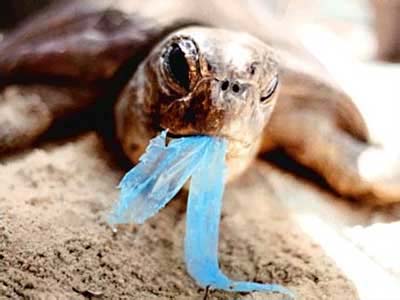PLASTIC
Plastic is the oceans worst enemy. Each year, approximately 1 million sea birds and a minimum of 100,000 marine animals such as whales, turtles, seals plus vast amounts of fish die because of plastic litter. These animals die from swallowing plastic by either suffocating, poisoning or malnutrition. Some times fish or birds get caught on the plastic (below), therefore either suffocating or starving to death. As a result many species are on the verge of extinction.  |  Animals swallow plastic because they think it is food. Many small pieces of plastic are shaped similarly to various sources of food such as plankton (above)  (Above) A birds carcass filled with plastic it had eaten. |
 Plastic debris can take the longest to breakdown when compared to other rubbish.
Plastic breaks down into smaller and smaller parts, making them every possible size for different animals to feed on. This chart shows how much plastic is made compared to how much is recyled and reused. | All of the worlds turtle species are endangered or threatened, mainly because of plastic debris. Turtles mistake plastic bags for jelly fish, which are a primary food source. The plastic bags block their digestive system or choke them. A dead turtle was found to have over 1000 pieces of plastic in its stomach. This includes a wheel of a toy truck, part of a plastic comb and guess what? Fragments of plastic bags.   Fact Plastic is even deadlier in the water because its toxins are released due to a reaction with the plastic properties and water. |
Humans are the only ones that can help stop plastic endangering wildlife. We will never be able to clear away all the plastic in the water but we can limit or even stop the tonnes of rubbish that gets dumped in the oceans.
To start with people, should stop littering, especially on beaches, rivers and any other place where it will be carried into the water. Basically people just need to be more responsible with their rubbish. Clean up days should be held more regularly, plastic bags should be banned, people should recycle, and the government would to need to follow through on protecting the environment.
For more information, or to help clean polluted areas, go to;
http://www.cleanup.org.au/au/NewsandMedia/waste.html
The Great pacific garbage patch
Once rubbish
enters the ocean- and it is not consumed by animals or washed up on
once beautiful shores- it follows the current.
The current will usually take the rubbish to one of the five major oceanic gyres. An oceanic gyre is an area full of swirling marine debris. The largest of these gyres is in the north pacific. It is known as the great pacific garbage patch or the plastic trash vortex and is twice the size of Texas, or 3 times the size of Britain. The rubbish is mostly parts of plastic, but there is also other debris including fishing nets. Studies show that 80% of the rubbish in the garbage patch comes from land pollutants and 20% from ships at sea. It
is unknown how big the plastic vortex is, as it is impossible to detect
how far down the rubbish is. Estimations made is that the vortex could
be between 700,000km2 and 1,500,000km2 large. Scientists believe there could be over 100 million tons of rubbish floating in the vortex. This has countless effects upon fish and birds.
|  The currents (above) pushing rubbish to the five major gyres (below)  |
Hawaii's blissful shores are under threat. Because Hawaii is situated in the center of the garbage patch, rubbish is washed on to the islands renowned beaches every time the tide flows in.
On the remote beaches of Hawaii, instead of sand, you get plastic, fishing nets, aluminum cans and a whole range of other litter. In some cases, you would have to dig through over half a metre of rubbish to get to sand. Birds are the biggest victims; especially the albatrosses who digest the litter and feed plastic to their young.
There are organizations that are researching and trying to clean the garbage patches up. There is also a multi-billion dollar project that is intended to help clean the great garbage patch. It is planned to start in 2010. For further information, go to;
The Marine Research Foundation Algalita mission statement "The Marine Research Foundation Algalita is dedicated to the protection of
the marine environment and its watersheds through research, education,
and restoration". For more info , go to Algalita's home page;
|